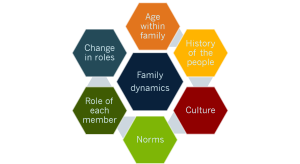Contents
What Are Family Dynamics?

Family dynamics have changed over the years. There are more single-parent families than ever before, and more people are living far away from their families. This has led to different ways of handling family dynamics, such as through technology. Families are also more diverse than ever, which can lead to conflict or new opportunities for understanding.
Family dynamics are the ways that a family interacts with each other. They can be defined by the way that family members communicate with each other, their roles within the family, and how they handle conflict. Family dynamics can also be shaped by the culture of the family, their religious beliefs, and the unique experiences that they share.
Examples of Changing Family Dynamics
Family dynamics have changed in a number of ways. There are more single-parent families than ever before, for example. In the United States, there are nearly 8 million single-parent households with children under 18. And In the year 1960, these accounted for only 9% of all U.S. households. In 2010, these made up 27% of all households. There are also more unmarried couples with children than ever before. In 1970, there were less than half a million of these families in the country. In 2000, this number grew to over 2 million.
There has been a growing trend for people to move away from their family and friends to live in different places. This has led to the challenge of families maintaining close relationships despite great distances between each other. People who move away from their family can sometimes feel like they do not have a strong connection with them anymore, while those who stay at home may feel jealous of the freedom and fun that relatives without children experience when they visit.
Family Dynamics And Technology

Technology has also played a role in changing family dynamics. The internet allows families to communicate quickly and send videos, pictures, or text messages to each other. People can spend more time together without being physically present by using technology for video chats, playing online games together, or spending time on social media sites together. Smartphones have made it possible for family members to stay in contact with each other all the time and keep up with each other.
Forms Of Family Dynamics

There are a number of different types of family dynamics. One way to look at this is by the way that family members communicate with each other. Parents and children may communicate through open communication, in which they share their thoughts and feelings openly with each other. They may also communicate through closed communication, in which they do not share personal information with one another. Or, they may communicate through conflict communication, in which they argue and fight with each other.
Another way to look at family dynamics is by the roles that family members play. Parents may have traditional roles in which they are the breadwinner and the primary caretaker of the children. Or, both parents may share parenting responsibilities equally. Or, one parent may take on the role of being a stay-at-home parent. Children may have traditional roles in which they are expected to be obedient and respectful at all times. Or, they may have renegade roles in which they can do what they want and get away with things that others cannot.
There are also family dynamics based on how families function together. A family could operate as a democracy, in which everyone is given an equal voice and has to come to a consensus before they make any decisions. Or, they may operate as a dictatorship that does not give other family members power or say in anything that happens. The family could also be patriarchal, in which the father holds all of the power and control within the family. Or, they may be matriarchal, in which the mother has all of the power and control.
How To Keep The Family Functional?

There are a number of ways to keep the family functional. One way is to have clear boundaries. Boundaries help to define what is acceptable behavior and what is not. They also help to prevent family members from crossing each other’s personal space. When boundaries are clear, family members know their roles and responsibilities within the family and what is expected of them.
Create Boundaries
Boundaries can be physical or emotional. Physical boundaries involve space, such as how close family members can get to each other or how much they can touch each other. Emotional boundaries involve the sharing of feelings and thoughts. Family members should respect each other’s physical and emotional boundaries.
Communicate
Another way to keep the family functional is by communicating with each other. Parents and children should communicate openly and honestly with one another, while still being respectful of each other’s wishes. They should also learn to compromise in which both parties are willing to give a little in order to come to an agreement.
Have Mutual Trust
Finally, it is important for family members to have mutual trust. This can be hard if there has been past conflict between or within the family. However, family members should not let the past damage their ability to trust one another. They should learn to put aside old grudges and focus on moving forward with a clean slate.
How To Handle Family Conflict?

Family conflict can be a difficult thing to deal with. It can cause tension and resentment within the family. Here are a few tips on how to handle family conflict:
1. Communicate openly and honestly with each other. This will help to resolve any issues that may be causing conflict.
2. Respect each other’s feelings and views. Even if you don’t agree with them, try to understand where they are coming from.
3. Try to compromise. This means that both parties are willing to give a little in order to come to an agreement.
4. Focus on the present, not the past. Don’t let old grudges get in the way of resolving current conflicts.
5. Try to remain calm and avoid getting angry or defensive. Avoid yelling or name-calling, which will only make the situation worse.
Why Boundaries In Family Are Important?

Boundaries in the family are important because they help to create a structure within which family members can feel safe and secure. They define what is acceptable behavior and what is not. Boundaries also help to prevent family members from crossing each other’s personal space. When boundaries are clear, family members know their roles and responsibilities within the family and what is expected of them.
Boundaries can be physical or emotional. Physical boundaries are those that involve space, such as how close family members can get to each other or how much they can touch each other. Emotional boundaries involve the sharing of feelings and thoughts. Family members should respect each other’s physical and emotional boundaries.
When boundaries are violated, it can lead to conflict within the family. Family members will not feel safe or secure, which can lead to resentment and anger. They may push boundaries with one another as a way of trying to exert power and control over each other’s lives.
Importance Of Family Dynamics

Family dynamics are important because they help to create a structure within which family members can feel safe and secure. They define what is acceptable behavior and what is not. Boundaries also help to prevent family members from crossing each other’s personal space. When boundaries are clear, family members know their roles and responsibilities within the family and what is expected of them.
When dealing with family conflict, it is important to focus on the present and not let old grudges or past conflicts get in the way of resolving current issues. This means that both parties are willing to give a little in order to come to an agreement.
Conclusion
It is evident that family dynamics play a significant role in one’s life. The way we are raised, the relationships we have with our parents and siblings, and the interactions within our families all contribute to how well (or not so well) we function as adults. While it is impossible to change our past, there are things we can do to improve our current family dynamics. In this blog post, we’ve looked at five ways to achieve healthier family dynamics. We hope you will find these tips helpful and that they will help you create a more positive and supportive home environment for yourself and your loved ones.
A Word From Therapy Mantra
Your mental health — Your psychological, emotional, and social well-being — has an impact on every aspect of your life. Positive mental health essentially allows you to effectively deal with life’s everyday challenges.
At TherapyMantra, we have a team of therapists who provide affordable online therapy to assist you with issues such as depression, anxiety, stress, workplace Issues, addiction, relationship, OCD, LGBTQ, and PTSD. You can book a free therapy or download our free Android or iOS app.


